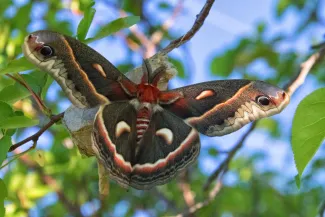
Help shed light on Oklahoma's moth community by sharing your sightings this #MothWeek and beyond. Cecropia moth by Kellie Carter/RPS 2020
Oklahoma’s moth community is filled with a variety of sizes, shapes and colors. But because the insects are most active at night, they can be easily overlooked and remain a mystery to many. One group of enthusiasts has been working to draw Oklahoma’s moths from their shroud of darkness and into the light.
The Moths of Oklahoma iNaturalist group, nearly 250 members strong, has spent years logging their encounters with Oklahoma’s unsung Lepidoptera and helping others appreciate the moths in their area.
“Oklahoma has such a rich diversity of moths,” said project creator Zach DuFran. “More than 1,600 species of moths have been cataloged through the project, and I suspect that number could climb to around 2,000 species.”
Photos and any sighting details of moths made in Oklahoma on the free iNaturalist platform are automatically added to the Moths of Oklahoma project. Species identifications aren’t necessary; iNaturalist will provide suggestions during the upload process, or the community of other iNaturalist users can submit suggestions after photos have been shared.
To get started, DuFran encourages people to leave their porch lights on and see what shows up. “You can even leave your light on overnight and check for moths the next morning. Just snap a picture, upload it to iNaturalist, and help grow our understanding of Oklahoma’s moth communities!”
National #MothWeek, held each July during the heart of Oklahoma moth’s flight season, brings moth-ers of all ages and abilities together as they literally and figuratively shine a light on their moth communities by observing and documenting what they see through photogrpahy and data collection.
UPDATE: The number of species reported to the Moths of Oklahoma iNaturalist project has increased to more than 1,900 species since this article was first published in 2021.